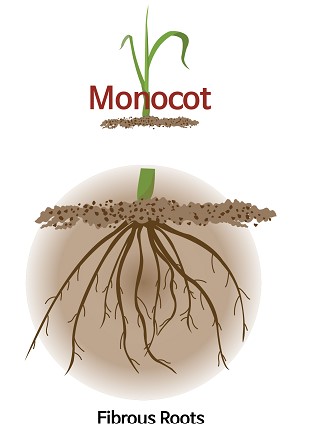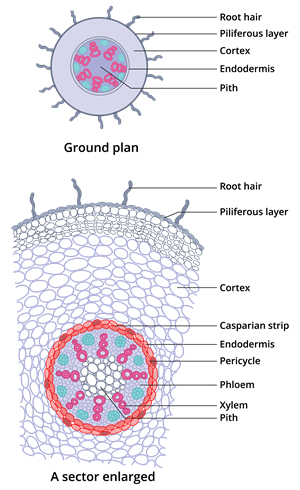
PUMPA - SMART LEARNING
எங்கள் ஆசிரியர்களுடன் 1-ஆன்-1 ஆலோசனை நேரத்தைப் பெறுங்கள். டாப்பர் ஆவதற்கு நாங்கள் பயிற்சி அளிப்போம்
Book Free Demo
Monocot root
Monocot root is fibrous root systems. It has internal structures almost similar to that of a dicot root.

Transverse section of monocot root
The above picture is showing a sector of the transverse section of a monocot root - maize.
The internal structures of the monocot root are almost similar to that of the dicot root. Both are having epiblema, cortex, endodermis, pericycle and vascular bundles.
The number of vascular bundles is more than eight in monocot root, while a dicot root is only four. Also, pith is large and developed in monocot root and is smaller in dicot root.
i. Epiblema:
It is the outermost layer present in the monocot root. This layer is made up of thin-walled parenchymatous cells without intercellular space. Unicellular root hairs are present in this layer, which helps absorb water and minerals from the soil. It is also known as Rhizodermis or the piliferous layer. Cuticle, a protective layer present in stems and leaves, is absent in the monocot root. Stomata, openings present in the leaf are also absent.ii. Cortex:
In the above picture of the monocot root transverse section, the largest cell zone in multiple layers is called the cortex. These layers are made up of thin-walled parenchymatous cells with large intercellular spaces, and these parenchymatous cells help in the storage of food and water.iii. Endodermis:
The innermost layer of the cortex is called as endodermis. This layer is closely packed with barrel-shaped cells. If the above picture is observed, we can see the band like thickenings on radial and tangential walls of the endodermis cells, called casparian strips. The strip is made up of suberin. Lignin will get deposited in the later stages. This strip acts as a water dam or check post to prevent the flow of fluids between cortex and phloem and prevents plasmolysis. Endodermis cells opposite to the protoxylem are without casparian strips. These cells help move water and dissolved salts from the cortex to the xylem and are called passage cells.iv. Stele:
All the tissues inner to endodermis constitute stele. It includes pericycle, vascular tissues and pith.
a) Pericycle:
A single layer or multilayer of parenchyma cells present inner to endodermis called pericycle. Lateral roots originated from this layer.
b) Vascular tissues:
It is a radial type of vascular bundle. Xylem is exarch ( protoxylem directed towards periphery and metaxylem directed towards the centre). And polyarch (more than eight xylem bundles and phloem present alternatively). In between the xylem and phloem bundles, there is a tissue called conjunctive tissue. In monocot roots, it is made up of sclerenchyma cells.
c) Pith:
Pith is present at the centre. It is made up of parenchyma cells with intercellular spaces. These cells stores food and contains an abundant amount of starch grains.
Video explaining the internal structure of a monocot root